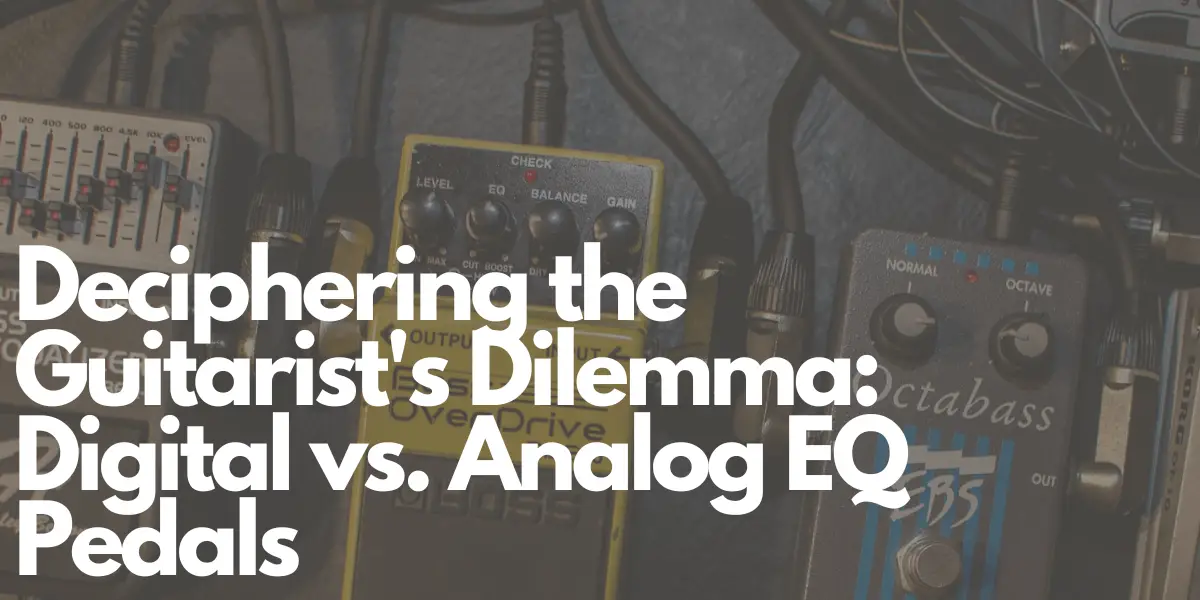When it comes to achieving that elusive perfect guitar tone, many guitarists turn to equalization pedals to shape and fine-tune their sound. However, a common dilemma arises: Should you go for a digital or analog EQ pedal? In this article, we’ll explore the digital vs. analog EQ pedal debate, weighing the pros and cons of each to help you make an informed decision based on your specific needs and tonal preferences.
Digital EQ Pedals: Precision and Versatility
Digital EQ pedals employ advanced digital signal processing techniques to modify your guitar’s tone. Let’s take a closer look at the advantages they offer:
Precision
Digital EQ pedals are all about precision. They provide unparalleled control over the frequency spectrum, allowing you to make pinpoint adjustments to your tone. This precision is perfect for situations where surgical accuracy is required to sculpt your sound just the way you want it.
Versatility
Digital EQs come with a wide variety of filter types, including graphic EQs, parametric EQs, and shelving filters. This versatility empowers you to tailor your sound to different musical genres and playing styles. Whether you’re shredding heavy riffs or playing soulful blues, digital EQs have got you covered.
Recall and Presets
Many digital EQ pedals come with preset capabilities, making it a breeze to switch between different tonal settings on the fly. This feature is particularly useful during live performances when you need to adapt to changing songs quickly. No more fumbling with knobs between songs; simply recall your presets and rock on.
Low Noise
Digital EQs typically boast low noise levels, ensuring a quiet signal path. This is a significant advantage when you’re working in a studio setting or using sensitive recording equipment. Your sound remains clean and pristine without unwanted interference.
Linear Phase
Some digital EQs offer linear-phase processing, which maintains phase coherence across all frequencies. In simple terms, this ensures that your sound stays transparent and natural, preserving the integrity of your guitar’s tone.
Analog EQ Pedals: Warmth and Character
Analog EQ pedals, on the other hand, rely on analog circuitry to modify your guitar’s tone, offering a unique set of advantages:
Warmth and Character
Analog EQs are renowned for their ability to add warmth and character to your tone. They often impart a particular “color” that many guitarists find appealing, making them the go-to choice for achieving a vintage, organic sound. If you’re after that classic rock or bluesy vibe, analog EQ might be your ticket.
Tactile Control
Analog EQ pedals typically feature physical knobs and sliders, providing a hands-on approach to tone shaping. This direct interaction with your sound can feel more intuitive and immediate, allowing you to tweak your tone on the fly during a performance.
Headroom and Transparency
Analog EQs offer high headroom, meaning they can handle high input levels without distortion. This quality is crucial for making subtle, transparent tonal adjustments while preserving your guitar’s dynamic range. Your sound remains clean, even when you push it to the limit.
Simplicity of Integration
Integrating analog EQ pedals into your pedalboard is straightforward, offering simplicity and ease of use. You don’t need to worry about complicated digital menus or preset banks; just dial in your settings with physical controls.
Finding the Right Fit
When deciding between digital and analog EQ pedals for your guitar, consider the following factors:
Tonality
What kind of sound are you aiming for? If you crave a pristine, detailed sound with precise control, digital EQ is an excellent choice. However, if you’re chasing a vintage, warm, and character-rich tone, analog EQ may be your preference.
Application
Are you primarily using the EQ pedal for studio recording, live performances, or practice? Digital EQs shine in live settings with their recall and preset features. Analog EQs provide a more tactile experience and are often favored for recording purposes.
Signal Chain
Take into account the complexity of your signal chain. If you have a more elaborate setup with multiple effects pedals, digital EQ can offer enhanced signal routing options and flexibility. Analog EQs may be a better fit for simpler setups.
Budget
Analog EQ pedals can sometimes be more expensive due to their vintage and boutique appeal. Digital EQ pedals often provide cost-effective options without compromising on sound quality.
In conclusion, the choice between digital and analog EQ pedals for your guitar hinges on your tonal goals and how you plan to use the pedal. Both digital and analog EQs offer distinct advantages, from precision and versatility to warmth and character. By understanding the nuances of each and considering your specific needs, you can select the right EQ pedal to shape your guitar tone according to your vision and musical style. It’s all about finding that perfect fit for your sound and style.
Author: Mike P
Hi! My name is Mike! I’ve been an apartment producer/musician for 10+ years. I’ve played in punk bands, released EDM tunes on Beatport and iTunes, and have a semi-successful stock music portfolio. Read more…


